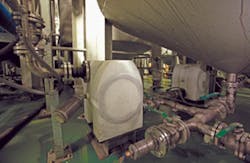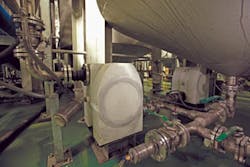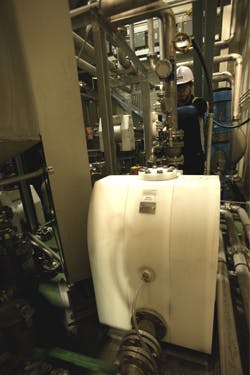“Laws are like sausages, it’s better not to see them being made,” – generally attributed to the 19th-century German statesman Otto von Bismarck
The same sentiment often applies to manufacturing—while you may be dazzled by the shine on the chrome of an automobile or marvel at your mirror-like reflection on the surface of a highly glazed piece of pottery, you really have no idea just how harsh the manufacturing conditions needed to be in order to produce the desired end result. Innumerable objects that we see and use in our daily lives only achieved their final form after a harsh production process that may have included the use of any number of abrasive media.
This article will examine several manufacturing applications or components where abrasive chemicals are used and the best type of pump to use in each process. Choosing the right pump not only ensures the desired final product is produced, but also enables the entire manufacturing process to be completed efficiently and effectively with minimum pump maintenance and downtime.
Hash Environments
Some examples of the types of manufacturing processes or components that may require abrasive chemical compounds include:
Pickling Baths: When metal is “pickled” in a process that is also known as tarnision, a surface treatment is used to remove any impurities, such as inorganic contaminants, stains, rust or scale that can discolor the steel. The pickling bath, or tarnision liquor, that is used to facilitate this treatment primarily consists of hydrochloric acid, though steels with an alloy content greater than 6 percent must be pickled in two stages—the initial hydrochloric acid stage, followed by submersion in another strong acid, such as nitric, phosphoric or hydrofluoric. Pickling is used in jewelry-making to remove the oxidation layer from copper, which occurs after heating. The waste product from steel pickling, known as pickling sludge, includes acidic rinse waters, metallic salts and waste acid, all of which make it a hazardous waste that needs to be neutralized with lime before it can be disposed of in a landfill.
Silicon Carbide Slurry: Slurry is a generic term for any type of thick suspension of solids in a liquid. Silicon carbide slurry is used in a variety of applications in the construction, ceramics, paper and explosives industries, among many others. It is made from a mixture of powdered silicon carbide that is suspended in polyethylene, diethylene glycol, or an oil-based fluid. Silicon carbide is an extremely hard, durable, heat-resistant compound. Grains of silicon carbide can be sintered together to help form very hard ceramics that can be used in the manufacture of such diverse products as solar cells, car brakes and bulletproof vests. Because of its degree of hardness, silicon carbide is often used as a cutting liquid, or slurry, in the manufacture of solar cells and wafers, for example. Most silicon carbide slurries are mixed by the manufacturer, who purchases the silicon carbide powder by the size of the “grit” needed, then mixes it with the preferred liquid. Once the slurry is created, it is pumped to storage tanks until needed.
Electroplating: Electrodeposition is the name of the process used in electroplating. In the electrodeposition process, metal ions in a solution are transferred via an electric field to coat an electrode. It is primarily used to deposit a layer of a material, such as a metal, on an object in an attempt to give it a preferred property, such as wear-resistance, lubricity or corrosion protection. The electrodeposition process occurs when the components are introduced to an electrolyte solution that contains one or more dissolved metal salts and other ions that enable the flow of electricity. Depending on the object that is to be plated, the electrolyte solution can be very abrasive.
Printing Inks: Printing inks are actually divided into two categories: writing inks and printing inks. Printing inks consist of two distinct subcategories; ink for conventional printing (where an image is transferred to the paper or object to be printed on via mechanical plate) and ink for digital non-impact printing (electrophotographic and inkjet technologies). All types of inks are made with a wide variety of components, many of which can be abrasive. Color inks, for example, are made with a solvent that is generally produced from petroleum distillates, linseed oil or soybean oil, while the pigments are made up of various dyes. Titanium dioxide can be used to adjust the color characteristics of color inks. All types of inks may also contain additives such as lubricants, waxes, surfactants and drying agents.
Lime Slurry: By definition, lime slurry is an alkali that is a suspension of calcium hydroxide in water. It has a variety of uses in industrial, municipal and environmental applications, such as metals precipitation, odor control, sludge stabilization, lime softening, and pH adjustment. While it is easy to pump by itself, when lime slurry reacts with water, a condition known as “plating out” may occur. When this does occur, all surfaces that come in contact with the lime slurry are in danger of being caked with lime, including the pumps that are used to transfer it, which can cause certain types of pumps to malfunction. Lime slurries can also contain additional abrasive solids, such as grit and pebbles, which can wear down a pump’s internal components and lessen its efficiency and reliability.
Ceramic Mass/Glaze: Mass finishing is a common method of finishing metals that cleans, deburrs and polishes the surface. An abrasive ceramic media is used to facilitate the finishing process. Glaze is defined as “a layer or coating of a vitreous substance that has been fused to a ceramic object through firing.” Before application, ceramic glazes can be abrasive, as they consist of miniscule shards of glass-forming silica in combination with a metal-oxide mixture consisting of sodium, potassium and calcium, which allow the glaze to melt; alumina, which stiffens the glaze and prevents it from running; colorants such as iron oxide, copper carbonate or cobalt carbonate; and opacifiers like zirconium oxide and tin oxide.
A Pumping Solution for Abrasive Applications
While many types of pumping technologies have been tried and found wanting in these (and other) harsh manufacturing applications, solid-body plastic air-operated double-diaphragm (AODD) pumps have proven to be a reliable performer where a wide range of abrasive components need to be handled safely, efficiently and reliably.
| Limitations of Solid-Body, Plastic AODD Pumps
While the solid-body, plastic AODD pump is a good fit for many harsh manufacturing processes, there are some application limitations end-users should be aware of. Most notably:
|
Solid-body plastic AODD pumps have many features that set them apart from other pump technologies when it comes to abrasive-handling applications. They do not require electricity, they are self-priming, and they can pump a wide range of abrasive media—from slurries to liquids with suspended solids. Plastic AODD pumps are positive-displacement pumps that have a diaphragm in each of their two pumping chambers. These diaphragms are connected by a shaft so when the compression stroke takes place in one chamber during the pumping process, the suction stroke takes place simultaneously in the other chamber. This results in efficient, reliable, cost-effective, repeatable operation when handling any number of abrasive liquids or compounds.
Today’s more advanced plastic AODD pump designs feature a solid body, and most are constructed of polyethylene (PE), which offers excellent abrasion-resistance when used with slurries and other abrasive media. The abrasion resistance of these pumps, thanks to their PE construction, is seven times higher than that of polypropylene—while having similar chemical-resistance characteristics—and 1.6 times higher than steel. Solid PE also delivers better sealing, higher static weight, smoother operation, and better torque retention than other popular materials of construction.
For specific applications where the pumps require conductive materials and/or component materials with universal chemical resistance, these pumps can also be constructed of PE conductive, PTFE (polytetrafluoroethylene), and PTFE conductive. There is also a wide range of versatility in the materials of construction that are available for the pump’s cylinder valves, including PTFE, while the diaphragms (EPDM, PTFE/EPDM and NBR) and ball valves (EPDM, PTFE, NBR and stainless steel) are also available in a wide range of materials.
All of the housing parts on these pump are tightened to each other via housing bolts. However, instead of single bolts that press punctually against the housing, all of the bolts are tightened against a diaphragm-sized ring on each side of the pump. This results in a more even spreading of the housing-bolt force and an increase in permissible bolt torque, which enhances safety and reliability. An optimized flow pattern reduces the pump’s flow resistance, which results in increased efficiency and lower air consumption.
It’s a fact of manufacturing—abrasive liquids and compounds need to play a role in the creation of some of the world’s most recognizable products. These products only get made, however, if the equipment used to produce them can meet the challenges of handling and transferring a wide range of harsh and abrasive chemicals.
Mike Solso is the Manager Segment Marketing—Chemicals for the Americas, for Almatec and the entire Pump Solutions Group (PSG). Mike has 17 years of experience in all aspects of integrating diaphragm pump technology into mainstream process applications. He can be reached at [email protected].




